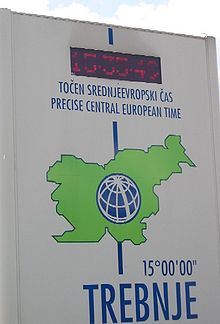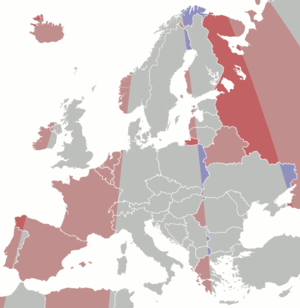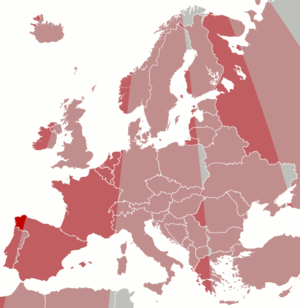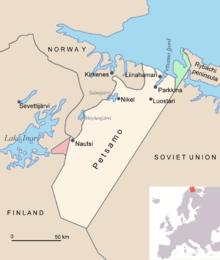- Central European Time
-
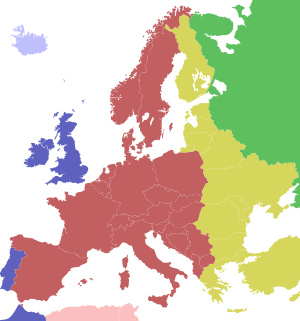 Time zones of Europe:
Time zones of Europe:
Light colours indicate countries that do not observe summer time: Algeria, Belarus, Iceland, Russia, Tunisia.blue Western European Time (UTC+0)
Western European Summer Time (UTC+01:00)light blue Western European Time (UTC+0) red Central European Time (UTC+01:00)
Central European Summer Time (UTC+02:00)yellow Eastern European Time (UTC+02:00)
Eastern European Summer Time (UTC+03:00)orange Further-eastern European Time (UTC+03:00) light green Moscow Time (UTC+04:00) Central European Time (CET), used in most parts of the European Union, is a standard time that is 1 hour ahead of Coordinated Universal Time (UTC). The time offset from UTC can be written as +01:00. The same standard time, UTC+01:00, is also known under other names.[clarification needed]
The 15th meridian east is the central axis for UTC+01:00 in the world system of time zones.
As of 2011 all member states of the European Union observe summer time, those that use CET in winter use Central European Summer Time (CEST) daylight saving time in summer, with UTC+02:00.
Contents
Usage
Usage in Europe
- 1884
- The areas of current Bosnia-Herzegovina, Croatia, Macedonia, Montenegro, Serbia, Slovenia start using CET.
- 1890
- 1891
- The areas of current Czech Republic start using CET.
- 1893
- The German Empire unified its time zones to use CET (MEZ).
- Italy, Malta use CET.
- Austria uses CET.
- 1894
- Switzerland switches from UTC+00:30 to CET
- Liechtenstein introduces CET.
- Denmark adopts CET.
- 1895
- Norway adopts CET.
- 1900
- Sweden adopts CET.
- 1904
- Luxembourg introduces CET, but leaves 1918.
- 1914
- Albania.
- 1914-1918
- During World War I CET was implemented in all German occupied territories.
- 1920
- Lithuania adopts CET, but recinds in 1940.
- 1922
- Poland adopts CET.
- 1940
- Under German occupation:
- The Netherlands were switched from UTC+00:20 to CET.
- Belgium was switched from UTC+00:00.
- Luxembourg was switched from UTC+00:00.
- France was switched to CET.
- Under German occupation:
After WWII Monaco, Spain, Andorra and Gibraltar implemented CET.
Portugal used CET in the years 1966–76 and 1992–96.
Proposed adoption in the United Kingdom
The time around the world is based on Universal Coordinated Time (UTC) which is roughly synonymous with Greenwich Mean Time (GMT). From late March to late October, clocks in the United Kingdom are put forward by one hour for British Summer Time (BST). Since 1997, BST has been aligned with the European Union's standards for CET and other EU time zones. Central European Time is thus always one hour ahead of British time.
Since the late 1960s, particularly since the 1990s, there have been arguments about the benefits of changing to a system based on Central European Time.
In 1968 there was a three-year experiment when the UK and Ireland experimentally employed British Standard Time (GMT+1) all year round; clocks were put forward in March 1968 and not put back until October 1971.[clarification needed] This provided an opportunity to evaluate the impact of aligning with other EC countries on daylight change on a number of issues, particularly road casualties. The conclusions were not clear cut. A review by the UK Parliament found it was impossible to quantify the most important advantages and disadvantages, and concluded that a decision on whether to retain the new system would depend on a qualitative judgement. Nor was the experiment universally popular: opponents, particularly those based in Scotland, highlighted an increased number of road accidents (many involving children walking to school) in the dark winter mornings; however, the Royal Society for the Prevention of Accidents (RoSPA), a strong proponent of a change to Single/Double Summer Time (SDST) in Britain, which would in effect align the UK with CET, has pointed out that this rise was more than compensated for by reductions in casualties in the evening and that, in all, 2,500 deaths and serious injuries were saved in each year of the trial period.[1][2] Nevertheless, the UK Parliament voted by a large majority to discontinue the experiment.
Benefits of a switch to CET that have been cited by RoSPA and supported by other leading organisations such as the Confederation of British Industry include not only improvements to road casualty figures but also benefits to the environment, business, tourism, leisure, health and well-being, crime and the elderly. In 2010, a Private Members' Bill tabled in the UK Parliament by Conservative Member of Parliament Rebecca Harris, which proposes a move to Single/Double Summer Time, received its first reading in the House of Commons on 3 December 2010, when the lawmakers voted by 92 to 10 in support. However, the Bill is unlikely to be passed without Government support, and at the end of the Parliamentary debate concerning the Bill the government minister responsible for this area of policy, Ed Davey, said the government opposed the Bill, because "the necessary consensus across all parts of the UK does not yet exist to justify a change, or the passing of any legislation on the matter".[3] Strong feelings for and against the proposal had been expressed in the British media. Newspapers such as the Daily Express supporting it, but others, notably the Daily Mail, opposed it, in a rare occasion where these two conservative tabloids disagree.[citation needed]
Central European Summer Time
The following countries and cities have introduced the use of Central European Summer Time between 1:00 UTC on the last Sunday of March, and 1:00 UTC on the last Sunday of October:
- Albania, regularly since 1975
- Andorra, regularly since 1984
- Austria, regularly since 1980
- Belgium, regularly since 1977 (before in 1916 and till 1940)
- Bosnia and Herzegovina, regularly since 1983
- Croatia, regularly since 1983
- Czech Republic, regularly since 1979
- Denmark (metropolitan), regularly since 1980
- France (metropolitan), regularly since 1976
- Germany, regularly since 1980
- Gibraltar, regularly since 1982
- Hungary, regularly since 1980
- Italy, regularly since 1966
- Liechtenstein
- Luxembourg, regularly since 1977
- Macedonia, regularly since 1983
- Malta, regularly since 1974
- Monaco, regularly since 1976
- Montenegro, regularly since 1983
- Netherlands (metropolitan), regularly since 1977
- Norway, regularly since 1980
- Poland, regularly since 1977
- San Marino, regularly since 1976
- Serbia, regularly since 1983
- Slovakia, regularly since 1979
- Slovenia, regularly since 1983
- Spain (except the Canary Islands), regularly since 1974
- Sweden, regularly since 1980
- Switzerland, regularly since 1981
- Vatican City, regularly since 1966
Other countries
For other countries see UTC+1.
Discrepancies between official CET and geographical CET
Colour Legal time vs local mean time 1 h ± 30 m behind 0 h ± 30 m 1 h ± 30 m ahead 2 h ± 30 m ahead 3 h ± 30 m ahead Legal, political and economic, as well as physical or geographical criteria are used in the drawing of time zones so official time zones rarely adhere to meridian lines. The CET time zone, were it drawn by purely geographical terms, would consist of exactly the area between meridians 7°30′ E and 22°30′ E. As a result, there are European locales that despite lying in an area with a "physical" UTC+1 time, actually use another time zone (UTC+2 in particular – there are no "physical" UTC+1 areas that employ UTC). Conversely, there are European areas that have gone for UTC+1, even though their "physical" time zone is UTC (typically), UTC-1 (westernmost Spain), or UTC+2 (e.g. the very easternmost parts of Norway, Sweden, Poland and Serbia). On the other hand, the people in Spain still have all work and meal hours one hour later than France and Germany even if they have the same time zone.[citation needed] Following is a list of such "incongruences":
Historically Gibraltar maintained UTC+1 all year until the opening of the land frontier with Spain in 1982 when it followed its neighbour and introduced CEST.
Areas located within UTC+1 longitudes using other time zones
Areas between 7°30′ E and 22°30′ E ("physical" UTC+1), all using UTC+2
- The westernmost part of Greece, including the cities of Patras, Ioannina and the island of Corfu
- The westernmost parts of the Bulgarian provinces of Vidin and Kyustendil
- The westernmost part of Romania, including most of the area of the counties of Caraş-Severin, Timiş (capital Timişoara), Arad, and Bihor, as well as the westernmost tips of the counties of Mehedinţi and Satu Mare
- The westernmost tip of Ukraine, near the border with Hungary and Slovakia, at the Ukrainian Transcarpathian Oblast (Zakarpattia Oblast), essentially comprising the city of Uzhhorod and its environs. (Although CET is used as local, non-official time in Transcarpathia).
- The Russian exclave of Kaliningrad, excluding however its easternmost slice (the city of Nesterov is east of 22°30′ E, but that of Krasnoznamensk is not)
- Western Lithuania, including the cities of Klaipėda, Tauragė, and Telšiai
- Western Latvia, including the cities of Liepāja and Ventspils
- The westernmost parts of the Estonian islands of Saaremaa and Hiiumaa, including the capital of the Saare County, Kuressaare
- The southwestern coast of Finland, including the city of Turku; also the Åland islands (of Finnish jurisdiction) – the Åland islands are the westernmost locale applying EET in the whole of Europe
- The northwesternmost part of Finland, including Kilpisjärvi and Kaaresuvanto.
Areas located outside UTC+1 longitudes using UTC+1 time
Areas between 22°30′ W and 7°30′ W ("physical" UTC-1)
- The westernmost part of mainland Spain (Galicia, e.g. the city of A Coruña); Cape Finisterre and nearby points in Galicia, at 9°18′ W, are the westernmost places where CET is applied.
- The Norwegian island of Jan Mayen lies entirely within this area and extends nearly as far west as Cape Finisterre, with its western tip at 9°5′ W and its eastern tip at 7°56′ W.
Areas between 7°30′ W and 7°30′ E ("physical" UTC)
- Andorra
- Belgium
- France, except for the absolutely easternmost part, in Alsace, incl. Strasbourg, and except for Corsica
- The very westernmost part of Germany, incl. the cities of Saarbrücken, Düsseldorf, Cologne, Aachen, and Trier
- The absolutely westernmost part of Italy, incl. the cities of Aosta in Aosta Valley and Cuneo in Piedmont
- Luxembourg
- Monaco
- Netherlands
- The westernmost part of Norway, incl. the cities of Bergen and Stavanger
- Mainland Spain, except for the westernmost part (see above)
- Gibraltar
- The part of Switzerland west of Bern (inclusive), also incl. cities such as Geneva, Lausanne, and Fribourg
Areas between 22°30′ E and 37°30' E ("physical" UTC+2)
- The easternmost part of the Republic of Macedonia, including the city of Strumica
- The easternmost part of Serbia, in the Pirot District, including the city of Pirot, and small easternmost parts of Bor District.
- The easternmost tips of Hungary and Slovakia, bordering to the north and south respectively the Ukrainian Transcarpathian Oblast (Zakarpattia Oblast), a bit to the east of Vásárosnamény, Hungary – Uzhhorod, Ukraine (both at 22°18′ E) line
- The easternmost part of Poland, including the cities of Lublin and Białystok
- The northeast of Sweden, in the Norrbotten province, including the cities of Kalix and Haparanda
- The northeast of Norway, lying north of Finland, roughly coinciding with the county of Finnmark; for instance Vadsø, the capital of Finnmark, has a longitude of 23°49′ E. Actually, the easternmost town in Norway, Vardø, lies at 30°51′ E, which is so far east, so as to be east even of the central meridian of EET (UTC+2), i.e. east of Istanbul and Alexandria. The sun reaches its highest point at 10:56 (when not DST).
The Norwegian-Russian border (incl. border passings such as Kirkenes) is the only place where CET (UTC+1/+2) borders Moscow time (UTC+4), resulting in a two hours time change (or three hours in winter) for the passenger crossing that border.
- More so, there exists a "tri-zone" point (where UTC+1, UTC+2, and UTC+4 meet) at the Norway-Finland-Russia tripoint near Nautsi. It is interesting to perform the following mental experiment when looking at this map: Go to the westernmost point of the red area (the Jäniskoski-Niskakoski area); this belongs to Russian jurisdiction, hence the time there is UTC+4 (formerly UTC+3). Then, take a northeastern (NE) direction (that is an eastwards direction); you will soon be crossing into Finnish territory, thus moving to the UTC+2 time zone. Continuing in that direction, you will eventually reach the Finland-Norway border and enter Norway, thus passing into the UTC+1 time zone. So, moving in a (north–)easterly direction, you will be moving from UTC+4 to UTC+2 to UTC+1.
See also
- Time zone
- European Summer Time
- Amsterdam Time
- UTC+1
- Other countries and territories in UTC+1 time zone
References
External links
Categories:- Time zones
- 1884
Wikimedia Foundation. 2010.

